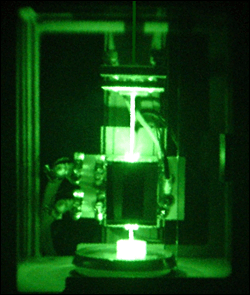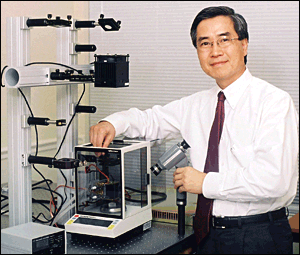
Thruster May Shorten Mars Trip
An amplified photon thruster that could potentially shorten the trip to Mars from six months to a week has reportedly attracted the attention of aerospace agencies and contractors.
Young Bae, founder of the Bae Institute in Tustin, Calif., first demonstrated his photonic laser thruster (PLT), which he built with off-the-shelf components, in December.

Young Bae's photonic laser thruster (Photo courtesy Bae Institute)
The demonstration produced a photon thrust of 35 µN and is scalable to achieve much greater thrust for future space missions, the institute said. Applications include highly precise satellite formation flying configurations for building large synthetic apertures in space for earth or space observation, precision contaminant-free spacecraft docking operations, and propelling spacecraft to unprecedented speeds -- faster than 100 km/sec.
“This is the tip of the iceberg," Bae said in a statement from the institute. "PLT has immense potential for the aerospace industry. For example, PLT-powered spacecraft could transit the 100 million km to Mars in less than a week.”
Bae founded the institute to develop space technologies and has pursued concepts such as photon, antimatter and fusion propulsion for more than 20 years at SRI International, Brookhaven National Lab and the Air Force Research Lab. He has a PhD in atomic and nuclear physics from UC Berkeley.
Several aerospace organizations have expressed interest in collaborating with the institute to further develop and integrate PLT into civilian, military and commercial space systems, Bae said, and he has recently been invited to present his work by NASA, JPL, DARPA and the Air Force Research Laboratory (AFRL).
Franklin Mead, a senior aerospace engineer at AFRL, said in a Bae Institute statement that the PLT demonstration and measurement of photon thrust is "pretty incredible. I don’t think anyone has done this before. It has generated a lot of interest."

Young Bae, founder of the Bae Institute (Photo courtesy Bae Institute)
The institute said Bae’s paper, “Photonic Laser Propulsion: Proof-of-Concept Demonstration,” was recently accepted for publication this year in the American Institute of Aeronautics and Astronautics' Journal of Spacecraft and Rockets. It documents how he overcame the inherent inefficiencies of traditional photon thrusters in generating thrust by amplification with the use of an innovative optical cavity concept.
"For decades, rocket scientists have tried to overcome the inefficiency of photon thrusters by amplification based on optical cavities separated from laser sources, but failed," the institute said. "In contrast, Bae’s PLT (patent pending) places the laser medium within a resonant optical cavity between two platforms to produce a very stable and reliable thrust that is unaffected by mirror movement and vibration -- ideal for spacecraft control or propulsion."
Bae will present at the AIAA SPACE 2007 Conference & Exposition, to be held Sept. 18-19 in Long Beach, at four sessions: Space Transportation Systems, Promising Space Concepts from the NASA Institute of Advanced Concepts (NIAC), Space Systems for the Next 50 Years, and Advanced Vehicle Systems.
The PLT research was partially funded by NIAC (NASA Institute of Advanced Concepts) as part of a spacecraft formation flight concept grant.
For more information, visit: www.baeinstitute.com
Published: September 2007